 |
||
|
||
| ||
Not long ago CD-RW drives were seldom met in home computers and were considered as luxury. The drives were expensive and had the unperfect mechanics. CD-RW disks were not cheap in comparison with more habitual CD-R disks and had the very much limited rewrite resource. Such drive was usually put together with the available disk drive on CD because CD-RW didn't suit the role of the standard CD-ROM. Today the situation has cardinally changed. CD-RW disk drives are more often met in domestic computers as the fundamental device for reading compact discs. The main reason was the price fall for media and recording devices. The achieved level of CD-ROM speed parameters played an important role in increase the number of CD-RW drives released by the manufacturers. There are some new interesting technologies of CD-ROM rate increase. One of the examples is TrueX technology offered by Zen Research and permitting to achieve maximum read rate 72x. The high price of the special reading head prevents this novelty from becoming promising. Taking into account this there is no wonder that CD-ROM manufacturers transfer to CD-RW drives production giving the perfect variant of plug-in memory for mass application. It is quite possible that soon CD-RW drives will cut out other CD devices until "combines" DVD/CD-RW come to this sector of the market. But such "combines" are still too expensive, and DVD disks are not so widely spread. Some time ago the development of CD-RW drives technology was a bit braked. The certain standard existed: CD-RW drives "of the initial level" usually had a combination of rates 2/2/16 (record/rewrite/reading) and some Hi-End with rates meeting to the level 4/2/24. Ricoh 6200, Acer CRW-6206A and Hewlett Packard 7570i can be the examples of "initial level" drives (for the last one the read rate is 24x). Plextor PlexWriter RW, Hewlett Packard 8100i and Sony CRX100E-RP can be referred to Hi-End. But for the sake of justice it is necessary to mark that there was the drive with the combination of rates 4/4/16. This drive was released in 1998 by Yamaha - CRW4416 with IDE and SCSI interfaces and it was popular due to high speed and moderate price. Practically together with Yamaha released CRW4416 Plextor released eight-speed models Plextor PlexWriter 8/20 and 8/2/20 (both with SCSI interface) much less popular and known than high-speed drives from Yamaha (first of all - owing to the high price for these recorders). Soon four-speed rewrite became the standard for CD-RW drives, but the writing rate for devices of the average price range in the majority of cases remained at the former level - 4x. Plextor known as the manufacturer of high-quality and expensive SCSI CD-ROM, CD-R and CD-RW drives has changed the former opinion about the standard rates combination. Having released PlexWriter PX-W8432Ti (8/4/32) with the interface IDE Plextor not only increased CD-R writing rate up to 8x, but also discovered the market of inexpensive mass CD-RW drives. Sony followed Plextor having released CRX140E/CH with the same rate combination and after some time having announced the more perfect CRX145E/CH. It was the drive with tenfold CD-R writing rate. Soon Plextor released PlexWriter 12/4/32. As it is clear from the title it was already a twelve-speed model that is close to the technological limit. It means that it will be hard to reach higher speeds without change of technology. Taking into account this other manufacturers decided to increase rewrite rate. As a result of this decision TDK announced the drive with maximum for today rate combination:12/12/32X. In the technology BURN-Proof from Sanyo the record suspension is used in the case if the buffer filling degree of the drive is close to critical. The new drive will have the interface IDE. After TDK and Sanyo has declared new model of the CD - RW of the drive, with the formula - 12/10/32. It is necessary only to wait for these models release and to find out their price. But already now it is possible to find Plextor PlexWriter 12/10/32 with the IDE-interface (!) supporting BURN-Proof technology mentioned above on sale. Plextor engineers developed new algorithms of storage and data transmission, included BURN-Proof support and decided 2 MBytes buffer will be enough. I hope we will soon check whether it is really so. One more question is where to find RW disks for ten-speed rewriting. They are not on sale yet (at least in noticeable quantities). Though CD-RW disks for 16x record released by the Korean company SKC have already appeared. Thus the record of the standard 650 MBytes disk will make only 4 minutes 38 seconds. Now it is necessary only to wait for 16x a CD-RW. UDF (Universal Disk Format) support made CD-RW disk drives usage very convenient and favourable for archiving, data storage and carry large data volume from one computer on another. UDF enables to work with CD-RW disk as with the hard disk. That is it is possible to use CD-RW as a usual floppy-drive: it is possible to copy, to delete and to rename files and directories. Existing methods of CD record:Disc-At-Once (DAO)In this mode the disk is recorded wholly at once, thus the laser is switched off only after all disk record. After completed record the new data cannot be recorded. This method is used at master-copy and AudioCD record. Track-At-Once (TAO)In this mode the record is carried out by tracks. That is the laser is switched off after each track record, therefore the two-second pauses between compositions are formed. At record in TAO mode it is necessary to point either to leave the disk "open" or "to close" it. It is possible to add information on the "open" disk, but the closed disk is copy-protected. Session-At-OnceOne or sometimes several tracks form a session. The laser working in this mode is switched off after the session record. The disk where more than one session is recorded is named multisessional. It is necessary to remember that the majority of musical centres and CD-players can't read multisessional disks (i.e. disks consisting of several sessions). And also that at several tracks record some free space is lost on the disk. So after the first session you will miss about 22 MBytes, after the second and further - about 13 MBytes. Packet WritingPerhaps it is the most interesting method of record. In this mode the disk writing is effected by "packets" that mean by small parts of the information. Using this method it is practically impossible to spoil the low quality medium because: first "the packet" is occupied only some kilobytes, it is completely in the drive buffer and at the lack of the following packet in the buffer the record is stopped until obtaining new one, and secondly the packet record rate is a little bit lower than in DAO or TAO. It is possible to effect record by packets both on CD-R and on CD-RW but before this it is necessary to format the low quality medium. Such programs as Adaptec DirectCD and CeQuadrat PacketCD serve for this purpose. The formatting process is rather long, it can last from twenty five minutes till one o'clock. After formatting it is possible to work with the disk as with the hard disk partition. It is an excellent way of record at CD-RW disks usage but not the best for CD-R because at file delete from CD-R disk there is no disk space increase. This way seems to be convenience and efficient, but everything is not so nice as it would be desirable. … Only modern CD-ROM drives can read disks recorded by this method and only supporting Multiread specification and (while) only in Windows (and not of all versions). The operation on implantation this record format support in other operating systems takes place, but even in Windows 95 some drives refuse to work in this mode. Older drives can probably read the disk but only in the case if the driver UDF (Universal Disk Format) is loaded. One more disadvantage of such method of record is that the formatted disk has only about 510 MBytes of free disk space. The fundamental record formats:CD-ROM Mode the 1/CD-ROM Mode 2Yellow Book specification. This format is the standard record format of computer disks with the data. CD-ROM XA - Compact Disk Read Only Memory eXtended Architecture (constant storage device of the extended architecture on the compact disc)Format where there is a possibility to add the audible signal and also the voice synchronisation signal to video for the sounded videoimage reproduction. CD - DA - Compact Disk Digital Audio (compact disc with digital audio)Red Book specification. This format is the standard format for musical compact discs (AudioCD) record. CD-I - Compact Disk Interactive (interactive compact disc)Green Book specification. Compact discs record format developed by the companies Philips and Sony Corporation and permitting to record sound information, digital data, nonmovable graphics images and videoimages of low-level quality lasting about 90 minutes on compact-discs. A disk recorded in this format can be played back by a special record player CD-I on the home TV- set together with sound track. The tracks recorded in CD-I format are not included in the disk (TOC) content, and so they are not visible on devices not supporting this format... CD - ExtraBlue Book specification. Disks with such record format are more and more often met. They recorded audiotracks and then data. Such way of record allows usual home musical players to play musical tracks without data readout. CD-I-Ready - (Interactive compact disc ready for reproduction on the CD-I device)This format where the long pause before the first sound track is used for image record was designed and offered for provision the compatibility with standard musical record players. CD - GRecord format of a musical compact disc with the additional textual or graphics information (classical example - Karaoke) CD - TextMusical compact disc record format with the additional textual (sometimes and graphics) information. Allows for example to record the title of the composition, the author's surname etc. together with the track to let it be highlighted on the display at playing on the musical centre instead of habitual Track1 etc. CD - VideoVideo-discs record format. It allows to arrange the compressed file (AVI or MPEG and similar) bigger than 650 MBytes by the quality close to VHS on the standard low quality medium. CD - BridgeRecord format offered for provision of compatibility with the discs reading equipment in XA format. At disc record in this format the data address marks of both formats - XA and CD-I are included in the content. Photo-CDFormat based on CD-Bridge. Is offered by Kodak for photoarchives storage which can be looked through the special device on the home TV-set. The fundamental CD-ROM reading modes.CLV - Constant Linear VelocityThe mode when the rotation rate at the internal (central) part of the disk read is at the maximum level gradually being reduced and reaching the external section of the disk. CAV - Constant Angular Velocity (constant angular velocity)The mode when the disk is always spun with the maximum rate, and the reading rate is increased as the laser head moves to the external part of the disk. P-CAV - Partial CAVCombination of the two previous modes. The mode when the reading rate on different sections is different but in whole remains on higher level than at CLV mode. The participants of testingFor testing the drives with write and overwrite rate not below 4x really present on the market were selected. The read rate for all drives was at a level 24-32x. In view of large enough size of each description they are given on separate pages. Hewlett Packard a CD - Writer Plus 9110i Testing techniqueAll drives were tested with the help of the test program from Ziff-Davis CDWinBench 99. The test was launched three times, then the average values were calculated. Each of drives should record one CD-R disk of the normal quality in DAO mode, one low quality CD-R disk in DAO mode and one CD-RW in the packet record mode. The drive skill to effect the record on 700 MBytes TDK CD-R80 low quality medium was also tested.
The write time was counted from pushing the button Record till the end of drive operation indication. The record was effected in Joliet format, Mode the 2:CD-ROM XA. "Noname"media were chosen as the low quality media for testing:
CD-R disks under the trade mark Philips Professional were chosen as normal quality media:
After that the recorded CD-R disks were tested on CD-ROM TEAC 540E and on the drive which has recorded the disk. The testing was carried out with the help of the program CDSpeed99 0.66 Beta. The program was launched three times, then the results were summarised and the average volumes were calculated. Also the program CD-ROM Drive Analyser ver. 2.1.1 was used at testing. The fundamental profile of the program CDSpeed99 is testing the drive and the record or compact disc quality. Therefore CD-ROM Drive Analyser allows to add CDSpeed99 in the field of testing the record and the compact disc surface quality. Nevertheless CD-ROM Drive Analyser also allows to make the definite conclusion about the drive speed characteristics. The quality of the obtained disks was checked as well as CD-ROM Drive Analyser with the help of utility CD quality check built-in in CD Speed. 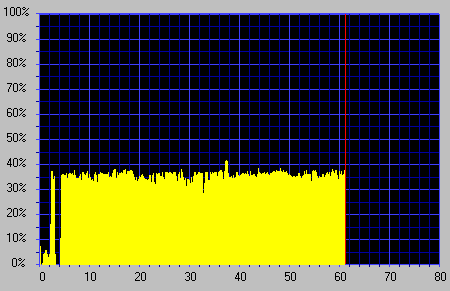 Data was recorded on CD-RW with the help of the program Adaptec DirectCD 3.01. The copying of 531 563 493 bytes in 5550 files from Windows Commander 4.03 jacket was effected. The files of different dimension (from 529 bytes up to 8 135 041 bytes) and such as (jpg, txt, mp3, rar, zip, exe) were selected. The quality of the recorded disk also was checked by CD quality check. Two CD-RW disks were formatted in Plextor 8/4/32 and Hewlett Packard 7570i. With the help of these disks the drive skill to read CD-RW disk formatted by another drive was checked. The disks were formatted by the program DirectCD 3.01, and the disk on the drive Hewlett Packard 7570i was formatted with the help " HP Fast Format ". By using the program CDDAE99 0.2 Beta 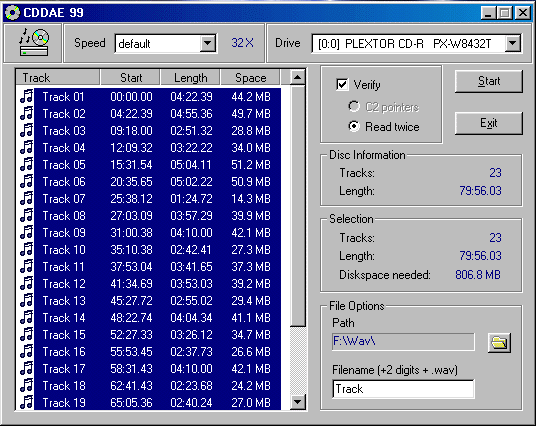 The tracks extract rate was measured from three AudioCD (two license and one - Chinese production) by using the program CDDAE99 0.2 Beta:
The principle of the program CDDAE99 0.2 Beta operation is the following: the musical track is extracted in WAV-file on the hard disk on the maximum possible rate. Then the program tests the obtained file to find some errors (which by all means will arise on high speeds) by bit comparison of the available file and the original. 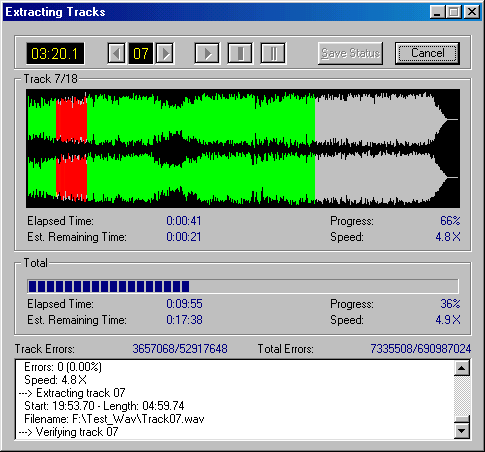 After that the average speed of the track extract and the quantity of errors (in percentage) got by the obtained file analization. Though the disks surface quality is rather good (the small-sized scrapes are present), nevertheless some tracks were extracted on separate drives only on rate 2x. For each AudioCD the test was conducted two times, then the results were summarised and the average volumes are calculated. "On hors d'oevres" was the rather scratched disk with deep scratches (we shall call it "Out-of-order"), one hardly exhausted by various drives with lots of scratches (we shall call it "Scratched") and one "gold" disk recorded three years ago. The drive basic skill to read even a part of this CD was tested on the first disc. As for the other two - the stability and reading quality was tested. The ability to read the scratched and gold disk up to the end even in the case of errors availability was very important. I would like to point the impossibility to grant the diagram of reading for "Out-of-order" compact disc because it is clear that the program CD-ROM Drive Analyser is unperfectly modified for such tests: at detection of some unreadable sections the program causes the complete system hang. So the results of the successful disk reading will be given in percentage. But I want to remark: all tests for reading check CAN NOT BE NAMED THE UNAMBIGUOUS CONCLUSION. The results of the tests are given as the fixing of the fact and no more. Therefore as always it is necessary to remember Vladimir Fedorov, the author of FAST CD-Test program:
It is also very difficult to simulate the large load on drives for checking their reliability. The situation when at testing the drive has shown itself only from the best side but at the large load it loses its positions and looks not so convincingly took place. Therefore any comments and remarks are only welcomed. The conditions of testing were the following:
Testing PC:All drives were installed in the system with the board ASUS K7M, the processor AMD Athlon 600 MHz, 256 MBytes PC100 SDRAM Micron (2x128 MBytes) RAM, IDE-hard disk of a IBM - DPTA-372050 20 GBytes 7200 RPM in PaloAlto 600 case. Windows98 SE reinstalling was effected before each drive test, then the drive software and IDE BusMaster last version were installed on defragmented section of the hard disk. Testing results:CDWinBench 99 CD-ROM Transfer Rate Rather interesting results were got. TEAC W54EK showed rather high internal data transfer rate for 32-speed model even higher than 40-speed CD-ROM. The remaining drives are at same level and demonstrate normal speed for devices of such class. Mitsumi recorder was the exception but it is not a surprise.  TEAC CD-ROM is the leader and it's quite natural. Among recorders the drive from TEAC showed the best results on internal data transfer rate. Plextor follows it, then Sony and Hewlett Packard devices. The low results of Mitsumi and Philips drives are caused by that they are 24 high-speed models. The CPU utilisation was:  The processor load at CD-ROM Transfer Rate tests was the greatest was for drives from Teac. Hewlett Packard 9110i drive showed good results at testing. CD-ROM Access Time Sony and Hewlett Packard showed different results, in this case Hewlett Packard drive showed higher results. The difference between 0,101% and 0,156% doesn't let you to feel the difference between HP and Sony at solving different problems. CDWinBench 99 CD-ROM Access Time The results are not unexpected - almost all drives confirm the stated characteristics of the access rate or even show the best result. TEAC drives were again distinguished. At stated 85 ms they exceeded this parameter. The most interesting result was demonstrated by the drive from Plextor: at the stated access rate 170 ms it showed 144 ms at Winbench99 test. Certainly it is lower than for other drives but this fact can please. CDWinBench 99 CPU Utilisation This test determines a common system load at drive operation in the system. As it was expected the greatest value was shown by TEAC W54EK, the least by Mitsumi. Sony and HP again demonstrated almost identical results. Time spent on CD record:Normal quality medium record:  The advantage of Plextor is obvious. It is necessary to point TEAC driver good results among four-high-speed recorders. HP and Sony showed practically the same results again. The smart design Philips didn't help this drive to demonstrate good results. Poor quality medium record(4x):  Plextor showed the best results, then TEAC follows with insignificant lagging (6 seconds) Philips is still behind. CD-RW disk (UDF) record:  Plextor showed 2 minutes lagging. The formatted disk record with the help of the program PacketCD lasted 21 second less, but the conditions of testing demand to put drives in equal positions. The excellent results were shown by HP and Sony. Mitsumi drive appeared in the list of the leaders, TEAC follows it with small lagging. Plextor helped Philips not to be the outsider again. Time spent on complete formatting of a CD - RW of the disk in UDF format In this test TEAC failed but it was its unique failure. Mitsumi showed high results in CD-RW writing rate test but failed in disk formatting for multiple record test. Philips became one of the leaders, it follows Hewlett Packard 9110 and Sony is behind. It is necessary to point that in this test the possibility of Hewlett Packard " HP Fast Format " drive which allows to record the data on the disk in six minutes after the beginning of formatting was not used. Plextor is in the middle of the table. The diagrams of the recorded normal quality compact discs reading (CDTest 99)
The diagram of the recorded poor quality compact discs reading (CDTest 99)
The green link on the diagrams is read rate (left scale), the yellow line is disk rotation rate (right scale, in thousands rpm). CD-ROM TEAC CD-540E showed on all drives almost the identical diagrams. The deflections were so small that the difference sometimes could be calculated only on numerical values. The unique exception was the diagram reflecting data reading recorded on poor quality medium with the help of Philips recorder. At DMA mode switched off the diagrams looked like this: 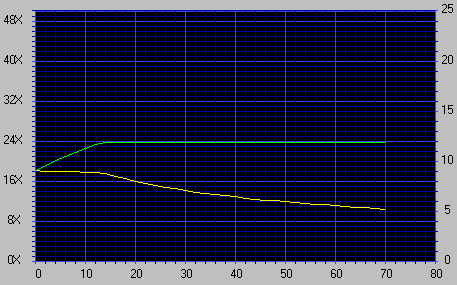 At DMA mode switched on the diagram already looked like that: 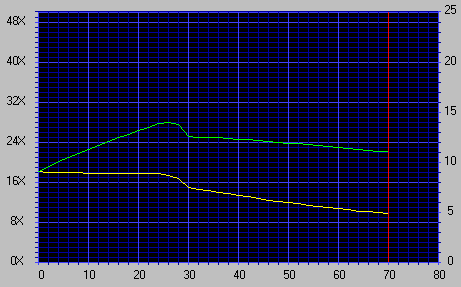 The diagram of reading the compact disc recorded by Philips recorder:  The given diagram was got at DMA mode switched off, because at switched on mode the diagram of reading sharply fell up to zero, then the disk continued to be read, but CDSpeed 99 completely hung the system. Therefore there is no diagram for studying. It can be caused by the defective low quality medium. But at the new record on the other low quality medium Philips PCRW404K recorder showed the similar result: the fall was watched again but already by the end of the disk and with smaller amplitude. We can suppose that this drive is not capable to carry out the stable record on low quality medium. Results of testing CD Speed 99 recorded normal quality compact discs
Results of testing CD Speed 99 recorded compact discs of poor quality
You could notice that the most equable diagrams were obtained for Sony, TEAC and HP normal quality medium. Mitsumi drive diagram is rather good too. It is interesting that the drive from Plextor has read the low quality medium better than the normal quality medium. The most stable diagrams on the low quality medium were shown by Mitsumi and Plextor. Results of testing CD Quality Check recorded CD-RW (UDF) disks
Results of testing CD Quality Check recorded CDs-RW (ISO) disks
In this test the devices from Hewlett Packard and Sony demonstrated excellent operation with CD-RW disks. It is necessary to mark TEAC and Plextor high results. Quality of the recorded normal quality compact discs (CD Quality Check)
Quality of the recorded poor quality compact discs (CD Quality Check)
n/a* - the drive is not supported by the utility,
the measurement was not possible
It is necessary to mark that not all drives are fully supported by this utility, therefore you won't see the diagram (it just won't be mapped), but the result will be all the same given in numerical sort (already averaged), or the program will signal about an error. Quality of the recorded normal quality compact discs (CD-ROM Drive Analyser)
Quality of the recorded poor quality compact discs (CD-ROM Drive Analyser)
I don't trust this test, but nevertheless some information from its results can be obtained. All the drives in this test except Plextor and Teac, the leaders of our testing, worked with rate 8x or about that. CD-ROM TEAC CD - 540E has shown the stable diagrams in all cases except one described above. Musical tracks extraction from audio compact discs (CDDAE 99)Piano Favourites
Acoustic Planet vol.2
Bloodhound Gang "Greatest Hits"
* - 3.04% means that the drive has extracted
with errors 3.04% of all disk. I.e. the remaining 96.96% audio data
were extracted without errors
Plextor again demonstrates high speeds and in musical tracks extract. Mitsumi 4804 TE extracted all tracks with very few mistakes. TEAC keeping the speed on 8,2x extracted the tracks with minimum errors. Sony was disappointing at test. Some tracks were extracted by it with about 90% errors. To avoid it we had to extract some tracks to extract on the speed 2x. Philips was not bad but a bit worse than Mitsumi. Direct data copying from the recorded compact discs on the hard diskThis test results were rather interesting. It is necessary to remember that the disk structure is complex and inhomogeneous, therefore the results were low enough even for 32 speed devices. Copying of the normal disk quality:  After WinBench 99 test results Plextor and TEAC leadership is natural. Mitsumi drive presence in the triple of leaders was unexpected. Philips was behind all again. Copying of the poor quality disk:  Plextor recorder leadership was only increased. As I already marked the poor quality disk was read even faster than normal. Out-of-order compact disks readingPlextor PlexWriter PX-W8432TiThe "gold" disk: 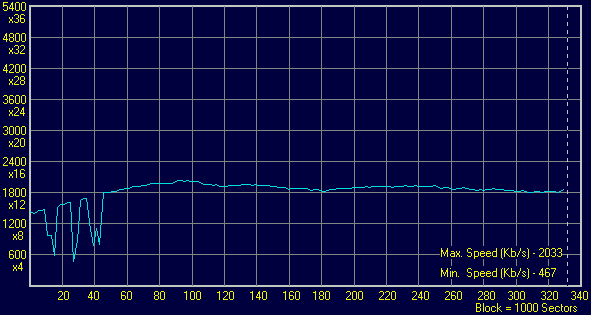 The scratched disk: 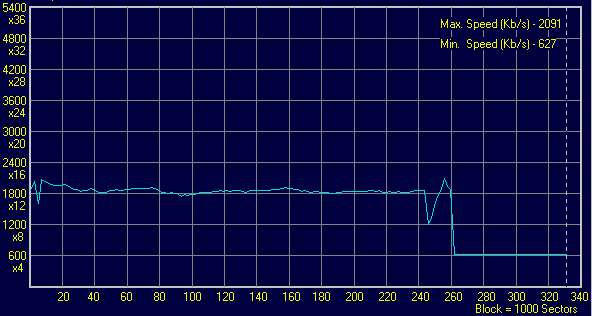 The "gold" disk has read with some complexities
in the beginning of the disk. The scratched disk began to read very well
but after one serious error reset the rate up to 4x. TEAC W54-EKThe "gold" disk:  The scratched disk: 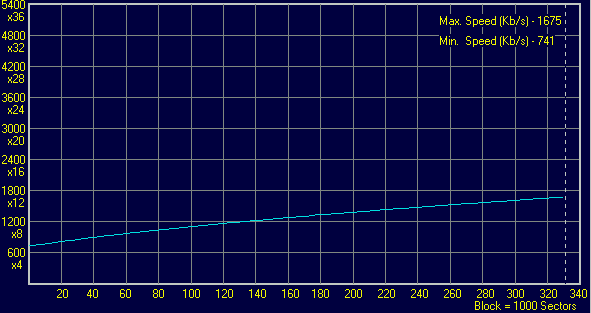 The "gold" disk reading for the given drive was stable and without errors. The diagram is equable. No error. The out-of-order disk was read on 68%. Mitsumi CR 4804 TEThe "gold" disk: 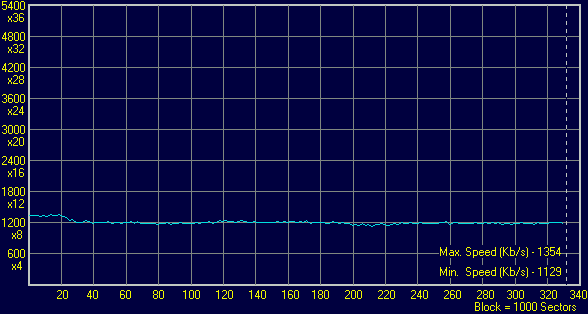 The scratched disk: 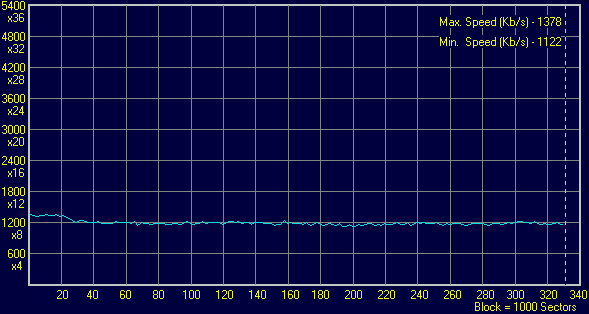 Reading quality of spoilt compact discs is one of the best. Only 8x, but so stable!:) The out-of-order disk was read on 77%. Philips PCRW404K The "gold" disk:  The scratched disk: 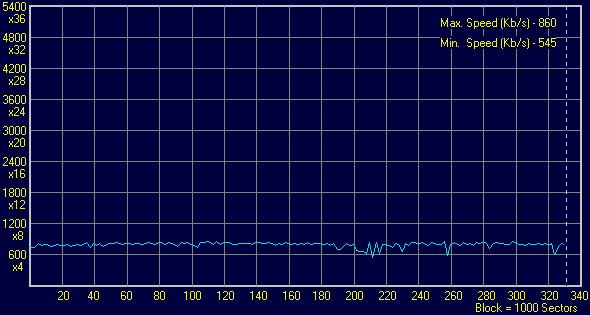 If there was no left scale, it would seem to look like the diagrams of Mitsumi drive reading. It is equable and without errors. The out-of-order disk was read on 60% Sony CRX140E-BPThe "gold" disk: 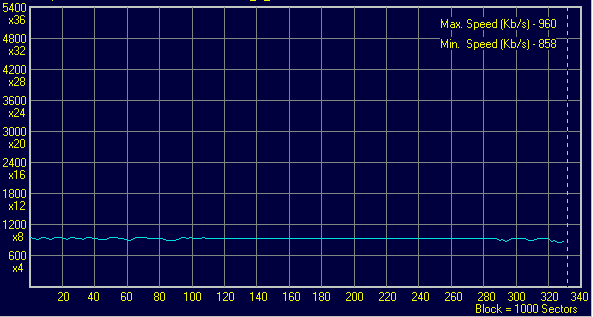 The scratched disk: 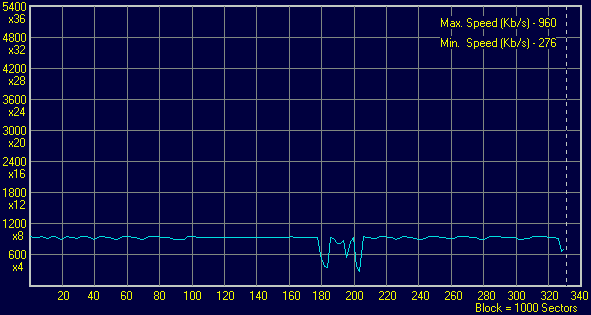 The "gold" compact disc reading does not call any remarks besides the rate - 6x is not the best result. The diagram is not equable. The out-of-order disk was read on 50% Hewlett Packard a CD - Writer Plus 9110iThe "gold" disk: 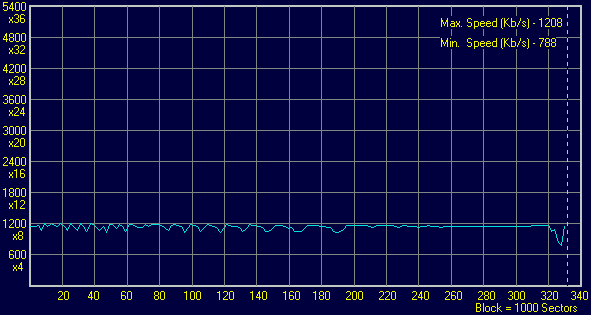 The scratched disk: 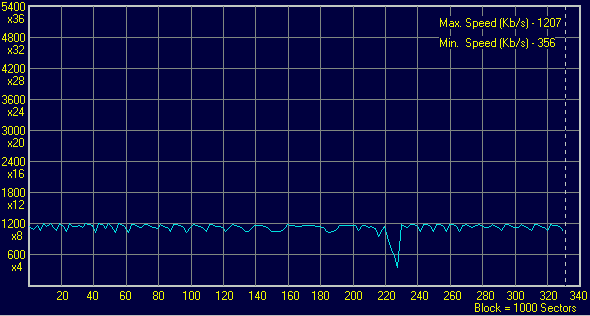 The diagram is wavy, though the amplitude is small. Hewlett Packard drive on the scratched disk has stumbled once, but has restored rate up to initial fast. The out-of-order disk was read on 62% ResumeAll the drives have perfectly coped with 700 MBytes low quality media. There were no problems with data reading. Each drive diligently has read the disk and has correctly determined its volume. Plextor PlexWriter PX-W8432TiThe tracks extract rate for the given drive on the high level. The excellent operation with CD-ROM disks, fast CD-R record. The large buffer allows to copy disks at once. No low quality medium was spoilt. The reading of the compact disc recorded on the eighth rate practically does not differ from the diagram of reading the compact disc recorded on the fourth rate. The large access time and mean operation with CD-RW disks slightly spoils the impression. Plextor is one of the best corporations supporting the users. Regular new versions and renovation of information are very important at operation with the device. TEAC W54-EKAs well as for Plextor this drive became the experiment in the field of creation inexpensive CDs-RW of devices with the IDE-interface. The debut was successful. This recorder is one of the best drives in its class, it writes perfectly. There are some small remarks to the buffer operation - it is very sensitive to the outside applications. Mitsumi CR 4804 TEThe drive anticipated only Philips recorder. The rates both reading and record are low. The buffer works stable, it is not so sensitive to the outside tasks. Philips PCRW404KThis recorder failed almost all the tests. Its drive operation is slow, it has spoiled one low quality medium. But the drive coped with the musical tracks extract from audio disk. Sony CRX140E-BPAll is good for this drive, but something is wrong with tracks extract and low quality medium record. The main features of this device are fast reading and qualitative record on normal quality medium. Hewlett Packard CD - Writer Plus 9110iHewlett Packard 9110i should avoid recording on the low quality media. The difference between it and the analogous Sony device is minimum and in general it is in the price. SummaryPlextor PlexWriter PX-W8432TiIt is the leader of our testing. Its results are not excellent everywhere, the price is simply huge, it is the first Plextor experience in the field of IDE-drives. But Plextor production is trustworthy and tested by many users for rather long time. CD quality is excellent even for recorded on high speeds. The buffer operation is excellent too even at Photoshop launch and at record on the 8-th rate the buffer was devastated up to 50% fast having been restored. The quality of reading both out-of-order and Chinese CD is rather good. TEAC W54-EKTEAC drive was good at testing. The company mainly produce read and record CD devices and floppy-drives of high quality. Acoustics plays an important role in its strategy. The four-speed record and overwriting will cover a large part of domestic users needs. TEAC is known for its reliable drives and this model is not an exception. Mitsumi CR 4804 TELow rates both reading and record are not good for the users, but domestic user recording up to three or four compact discs per week and sometimes archiving the data on CD-RW will probably be satisfied with this model. The low price for the drive is attractive. Mitsumi device will become a good addition to the available CD-ROM. This drive is the most silent in the review, vibration is practically absent. The reliability is not constant. Philips PCRW404KPhilips PCRW404K recorder stable demonstrates low results. The drive is rather noisy and vibrates at reading disks on high speeds. But the design is perfect. Sony CRX140E-BPThe recorder is very silent, the vibration is not felt. Reading quality is excellent. CD-RW disks reading is one of best among the drives from our review. The rather low price for the eight-speed device increase the interest to this drive. Hewlett Packard CD - Writer Plus 9110iEverything was told about Sony CRX140E-BP can be referred to the drive from Hewlett Packard, but Hewlett Packard drive design is nicer. As for the drive quality it is rather good. In the following browse:
The programs used at testing:
Write a comment below. No registration needed!
|
Platform · Video · Multimedia · Mobile · Other || About us & Privacy policy · Twitter · Facebook Copyright © Byrds Research & Publishing, Ltd., 1997–2011. All rights reserved. | ||||||||||||||||||||||||||||||||||||||||||||||||||||||||||||||||||||||||||||||||||||||||||||||||||||||||||||||||||||||||||||||||||||||||||||||||||||||||||||||||||||||||||||||||||||||||||||||||||||||||||||||||||||||||||||||||||||||||||||||||||||||||||||||||||||||||||||||||||||||||||||||||||||||||||||||||||||||||||||||||||||||||||||||||||||||||||||||||||||||||||||||||||||